This is the last instalment in our series of master classes with Steffen Peters, a truly gifted teacher of horse and rider…
There are a number of approaches to the Master Class.
There are a couple of seasoned performers – like Kyra Kyrklund and Anky van Grunsven – who have turned the Master Class into a polished theatrical performance. It’s just a matter of pay them the performance fee, and press the start button and off they go. And the advice they dispense is all good sense – it’s just not such a great idea to back up for another performance because you are likely to find even the jokes are the same.
There’s the other option where the organizer hasn’t done his homework, and just invites a rider with a big name without checking their coaching or communication skills, plonks them into the big arena and leaves them there to die…been to one of those?
Rarely, very rarely, there is an instructor with a level of concentration and focus combined with a natural ability to communicate, and a degree of self-esteem that does not require showing the world his or her brilliance, who actually trains and coaches. Hubertus Schmidt was like that at DWTS in 2006 – and Steffen Peters is from the same mould.
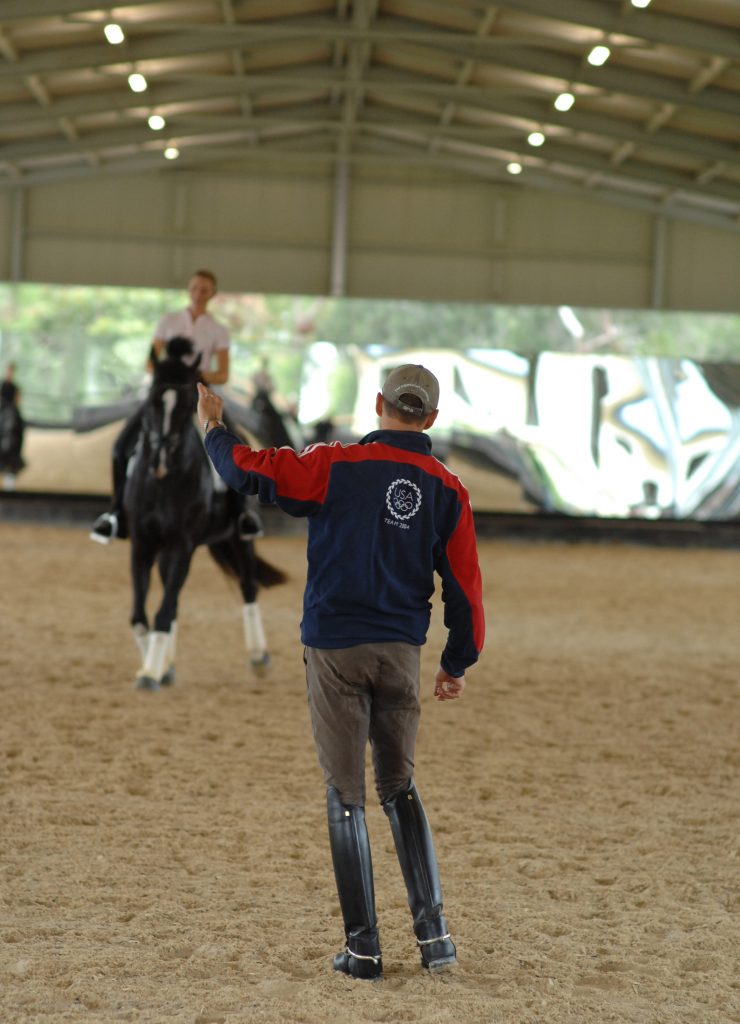
Right from the start, Steffen set the tone:
“I’m not here to show how it looks in the show ring but the share the knowledge I’ve learnt from my horses.”
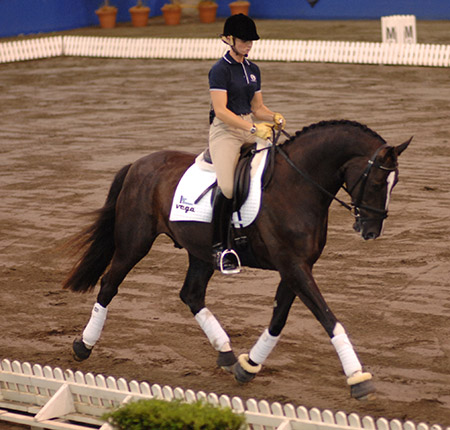
Kate Taylor-Wheat’s World Star is still having a few problems with his changes, a stride late with the hind leg – and right away, the big crowd is given a taste of Steffen’s approach:
“If you are dealing with a problem with the flying changes, you can ride all kinds of fancy exercises but if the horse is not on the aids, you are in trouble.”
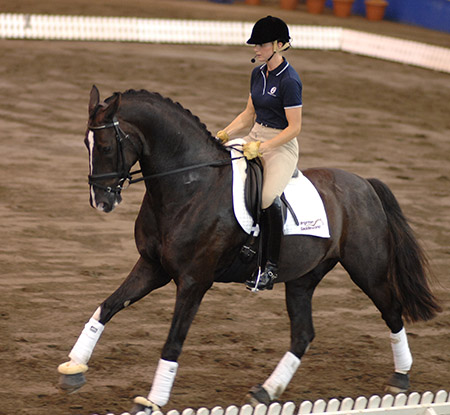
And guess what, it all starts in the walk…
“In the walk your horse must be 100% sensitive to the leg aid, and stay away from that little kick, the kick gets attention but it is better to close the leg, and if necessary, a touch with the spur. Think about a one-second aid, a calf driving aid – with the spur the emergency aid. In the warmup you are not just working on their muscles – it’s relatively easy to get a horse fit and strong, more important is that he 100% understands what is wanted.”
“Okay right now the horse is too low for competition, and behind the vertical, but when the horse is supple, then we’ll put him on the vertical. The first rule of the training scale is rhythm and suppleness, but so many riders just worry about rhythm. Even a three-year-old must be supple.”
“I like my horses equal on both reins. Some riders say they want them more into the outside rein, I want both equal. When the horse properly learns to yield to the leg, he will yield to the rein…”
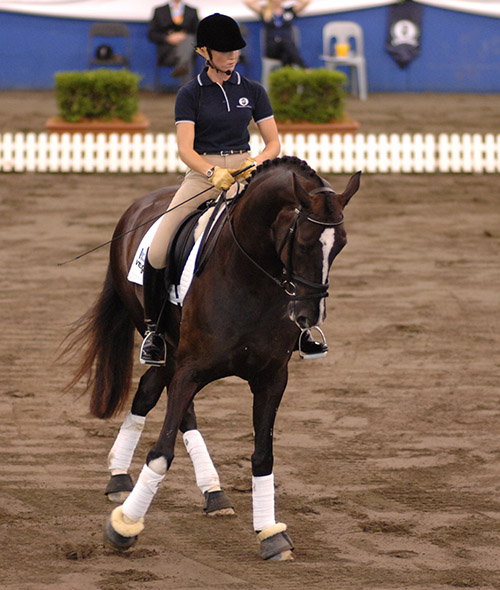
It was time to work on walk pirouettes and once again, Steffen was reminding Kate not to let the horse trick her into supporting him with her aids – “it’s a reminding aid, a little strength momentarily, even if we get a trot step, the last thing we want is a lethargic step. If it is not happening in walk, you have no hope in canter. Is he listening to the aid or getting numb to the aid? – that’s the worst scenario. If the horse isn’t responding to the aid, analyse it every day – you can compromise on expression but not on the response to the aid. Even after the horse has just been two weeks under saddle, you should have pretty high expectations about his response to the aids.”
“If the horse has learnt to push into our leg, then it is very hard in a flying change, not to get a late change. You don’t want to have to push every stride, your legs passively there should be enough to move the horse forward.”
next back to walk
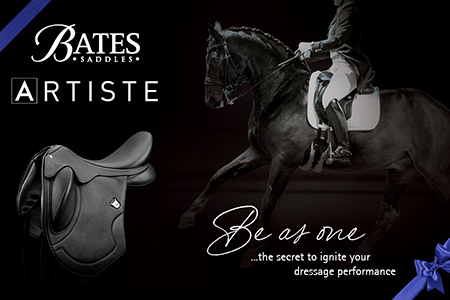
Back to walk again and the right walk pirouette to make World Star sensitive to the right leg – and when we go to canter… he gets both his changes clean first time!
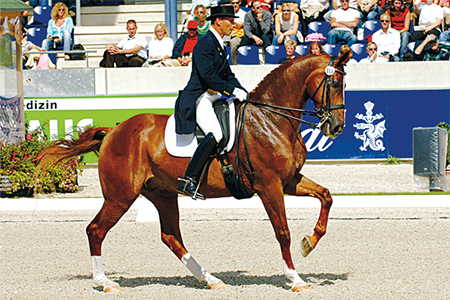
Floriano – he used his own muscles to carry himself…
“It’s all to do with straightness, if on the diagonal we have to think about ten things, that’s too many things to think about. At the end of the day, the most rideable horse puts in a clean test, and then if you have some highlights, you can score. For example, Floriano did not have a great piaffe, but he made the work look easy, he used his own muscles to carry himself.”
One of Steffen’s techniques was to use the whip as an attention-getter rather than a forward driving aid:
“If he breaks into canter from trot, touch him with the whip – hey buddy listen to me.”
It was time for Steffen to listen to the audiences, and seemingly affected by the quality of the presentation, they were intelligent questions!
Why not two whips?
“I like to stick to the FEI rules, and you can only warm up with one whip. It’s a crutch we can’t use at the show. I like a little more classical approach – one whip.”
Was the walk pirouette preparation for the flying changes something you always do – or just for this horse?
“It’s very individual for this horse. He loves to push your right leg and he can build up quite a bit of resistance, so it was easier in walk, to introduce the lateral movement.”
story continues after the advertisement
And if the horse doesn’t listen to the aids?
“Simple, in walk Kate’s horse might be large and beautiful but we also want quick, if you push and don’t get a response, go trot, and if you don’t get the response in trot, go canter. That tenth of a second kick is not so productive, it gets the horse’s attention – What do you want? But he doesn’t flow forward, it’s not a driving aid. Ask a little longer, then passive. Do the movements with the calf on the side, not supported by the spur.”
Story continues under the advertisement
What do I do if I ask for travers and my horse canters?
“It happens many times. Make sure in the canter aid, you take the leg back and then put it on, a clear canter aid. The aid for travers should be a very gradual movement.”
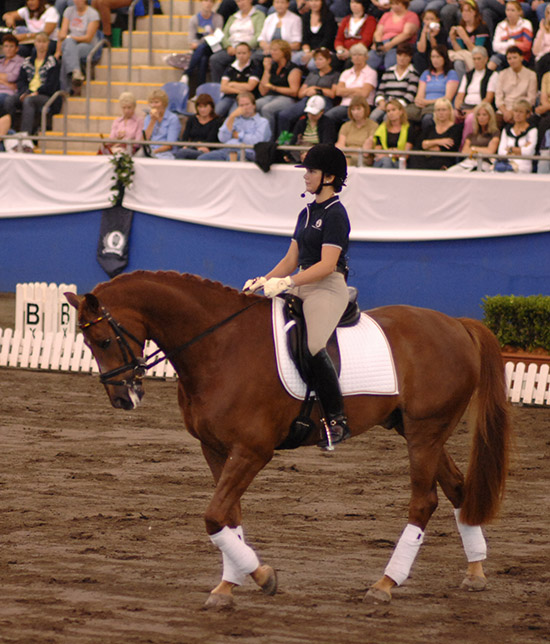
The next horse in was the baby – Anna Krups’ Reverence F. According to Steffen: “On the first day we worked together, this horse sometimes had too much of a desire to go forward. Yes, for the higher levels, we need a serious go-button, but we also need a brake. Let’s work on the transitions and remember just repeating the transition without correcting, the horse won’t learn. Use your seat and leg, but we also use the rein. It’s perfectly okay to increase the contact with our hands as long as when we release, the horse stays in the same frame.”
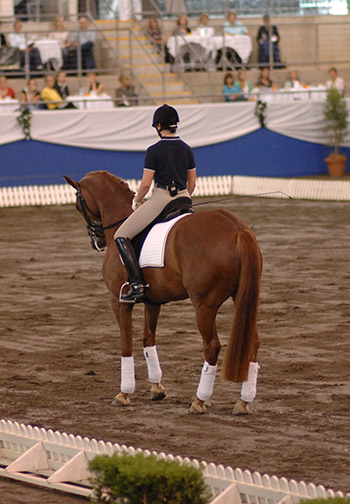
Once again, Steffen is using the whip as an attention getter: “If he horse grabs the bit, I’ll give him a little tap. If we give a perfect aid and ask for halt, and he does it two steps later, it’s time for a little tap with the whip. I’m not a great fan of using the whip to go forward. Again, if you are going across the diagonal, and you want to shorten at X, tap with the whip before the transition, get the hindlegs engaged.”
“If you come to a halt and you can’t release, then the halt is not finished. Finish 100%, don’t compromise.”
And when we do go forward, be careful: “Forward is wonderful but it must never be an evasion.
Suppleness and self-carriage come before expression… every inconsistency needs to be corrected.
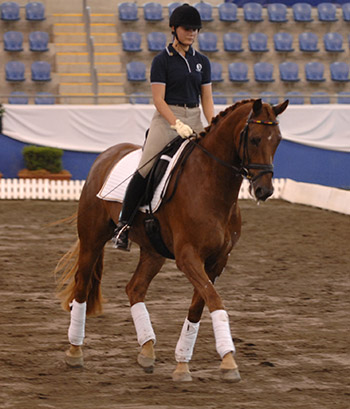
Stretching means that when you give an inch, he takes an inch; lots of horses use it as an excuse to fall on their forehand. If you go rising, that is no reason for him to grab the bit. If we allow a young horse to run through our hands and just say ‘oh he’s young, give him time’, we make problems for ourselves. You must have certain standards and expectations, don’t compromise. It is so important to have an experienced rider on a young horse to make logical decisions.”
And again the questions were interesting – as were the answers.
You say don’t let your horse go too low, what do you do if your horse wants to go low?
“Well the German explanation is don’t let him. Analyse the horse’s temperament – think about his conformation. Some horses are naturally low, and you need to strengthen the back of horse like that, that horse needs a rounder topline, but he should not take advantage of that. If you go walk to halt, and the horse increases the pressure on the bit, give him a little tap or the horse learns to be numb in the mouth, and they don’t care about the hand.”
“They have to learn to release on the slightest pressure and a little tap can help.”
It is not always physical, it can be mental, the horse learns to evade. The horse can use his muscles to carry himself, or to evade, that’s when they learn to lock up. We are more than happy to give the rein, but the horse must give first. It’s okay to use strength for a second, but get done. Momentarily firm, then release.”
If you get your horse to a competition and it is tight and spooky, what do you do?
“If I take a horse to a show, and it’s not ready, I don’t show them. Expose them to the situation – there’s not a single exercise you can use to improve the horse at the show if you don’t expose them to the environment. When you get to a World Cup final in front of 20,000 people in a tight arena… you need exposure before you go there.”
It was time for Donna Carrera and Rozzie Ryan to join Steffen in the school, and again, Steffen was warning about getting the horse too deep:
“Be very careful not to just get her lower and rounder and softer so that she gets overly round and leans on your hand. Round in the poll but at the base of her neck, no.”
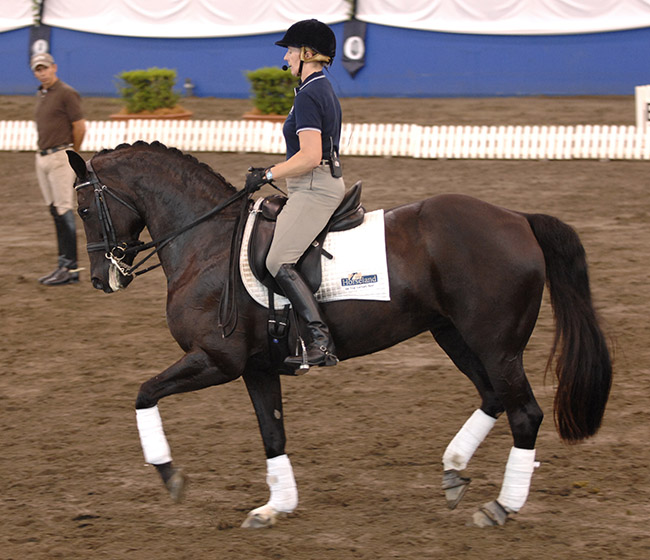
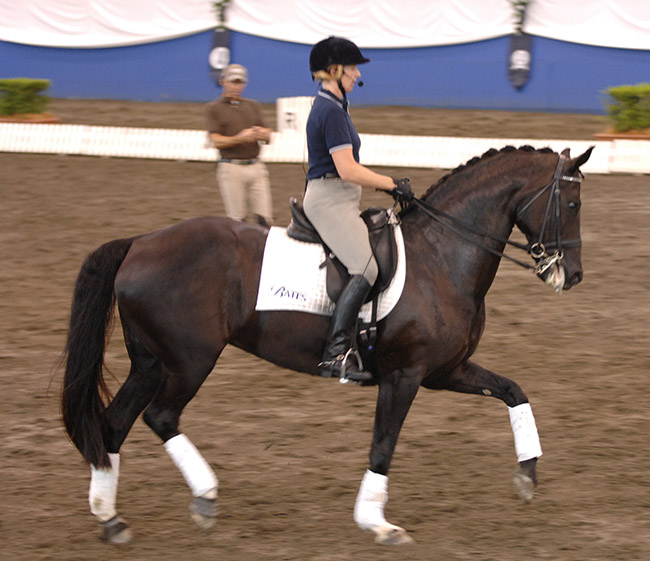
And always the point was made that when you are training you are doing just that…
“If you are approaching a canter pirouette it is so easy to just worry about the movement. NO. The first thing on the training scale is suppleness. The horse must always be perfectly in front of your leg. When we shorten the strides in preparation for the pirouette, the horse must always be in front of your leg. You can compromise on collection but not on the reaction to your leg. The pirouette is counter-productive if the horse is behind the leg – get out of it.”
“Don’t let her trick you into too much leg aids. Ride the pirouette passively and find out if she is becoming more honest. By supporting her a little less, you find out if she is reliable for the show arena.”
Once again, Steffen demonstrated his amazing attention to detail, and I wonder just how much his teaching style had been subtly influenced by that highly developed American style of jumping teaching that is also as picky as hell. Every now and then, it might have been the great George Morris sitting in charge of the microphone.
“In the transition from extended walk to collected walk, she’s discussing it. Don’t discuss. There should be a clear understanding – gently squeeze to the rein, don’t discuss it.”
“It is so important to me as a trainer and coach to ask the rider how it feels. It doesn’t matter if it looks good enough to me, even if it looks a 9, if the rider can’t be sure of it in the show arena. A good coach allows the rider to have some freedom. I am amazed when I go to an international show, and there in the warmup arena, the coach is giving a riding lesson – it’s too late for that. The coach is simply eyes-on-the-ground to give the rider confidence.”
“Be careful if you increase engagement and the horse goes rigid, that is counter productive. Increase engagement, increase lightness.”
And remember, this is not a test…
“Instead of riding a bunch of changes and getting crooked, ride less changes and work on keeping them straight. Make a little leg yield and make the horse straight in the change. There, you lost it in the first stride of the diagonal – turn off, circle in the corner and let her know, don’t go across the diagonal when she is against you. Every single issue is a training opportunity. Never in a million years accept that the horse is braced against your hand – not in halt or walk, not in passage or piaffe.”
It was time to try some half steps and once again Donna tensed up: “She’s tricking you into holding – push her sideways, it doesn’t matter if she piaffes in the leg yield, but make her supple – and praise her when she lets go. Prove to yourself that you can establish flexion and release and keep it. The piaffe is good Rozzie but it is too dependent on your aids. Be creative, don’t just cruise.”
“Before you start the half pass, don’t take a chance, make sure the horse is through and supple even if it takes another ten minutes. It’s not expression, it’s suppleness and sensitivity to your leg.”
And sure enough, it was a super half pass.
Again in the piaffe Steffen was asking Rozzie to check the quality of the work: “A passive transition to piaffe. Find out if she is honest, do it with your heels down. You don’t have to teach better piaffe, or better passage, just more reliable passage and piaffe.”
“The essence of dressage is maximum expression with the rider not supporting the horse.”
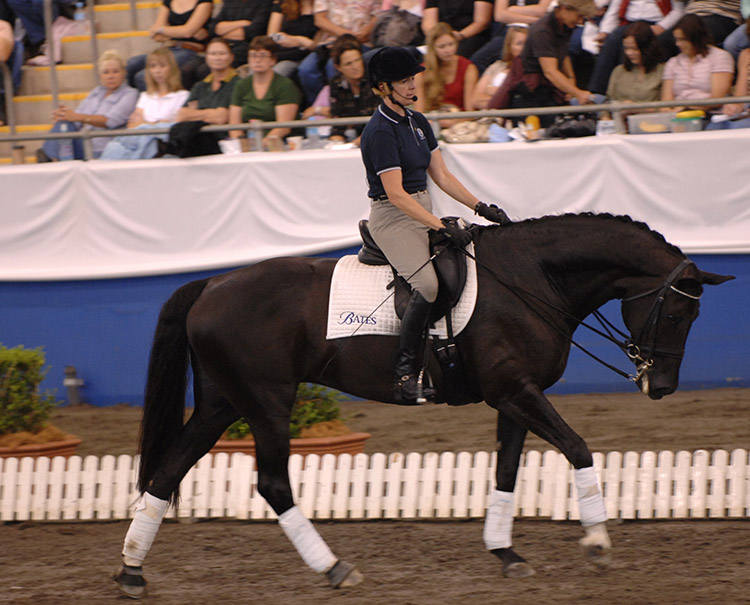
More intelligent queries:
Do you workout? What is your strategy to stay focussed at a big competition?
“I have a personal trainer and I work out at least twice a week in the gym. We are Olympic athletes… On the day of the competition, I separate myself from the crowd, and look at the arena, and go through every movement and know where the horses strengths and weaknesses are. I’ve done this since I was fourteen or fifteen, my dad taught me to do this with the ponies.”
In the warmup do you do the things you do well or difficult things?
“Usually the things that are easier for the horse. Floriano had difficulty with piaffe, and you’d get a levade if you asked too early, you had to wait til the very end. It was tempting to start piaffe right away, I’d have to say to myself, have patience, it works at home, it will work here. I don’t believe in a long warmup even with hot horses. Always walk for five minutes before you trot. Horses have a certain temperature when they show best – stick to the routine that works at home. It’s all planned, I work to the minute.”
The next horse into the arena was young GB William and once again, Steffen’s attention to detail is to the fore:
“When Glennis first brought him into my class, I looked at the bridle. I always do, if the bridle is not comfortably adjusted, we are not going to reach our goals. But he’s more comfortable without the flash on the noseband, it’s important to recognize that the rider knows the horse better than someone who has just flown in.”
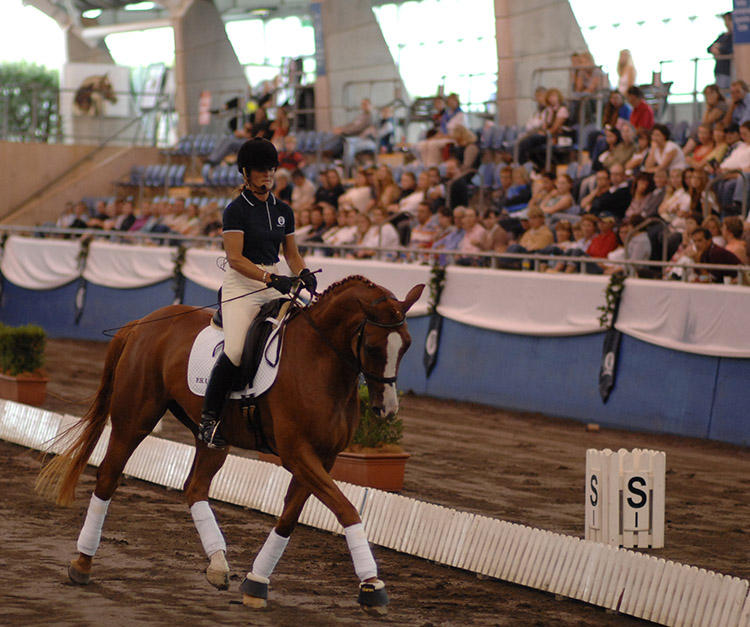
“With this horse we spent quite a lot of time getting him nicely forward. When Glennis started she was a bit too accommodating – he likes a lower frame, but when I got on him there was too much in my hands. Since he loves to take advantage of being downhill, we’ll work him in an uphill tendency. And we are working on getting the reaction quicker. We know he can go forward but we don’t know if the reaction is quick enough. In America we have a speed limit, but there is no limit on how fast you can go from 0 to 60! I know he can do 60, it’s how quickly he can get from 0 to 60. Without sensitivity to your leg then it is hard to get collection.”
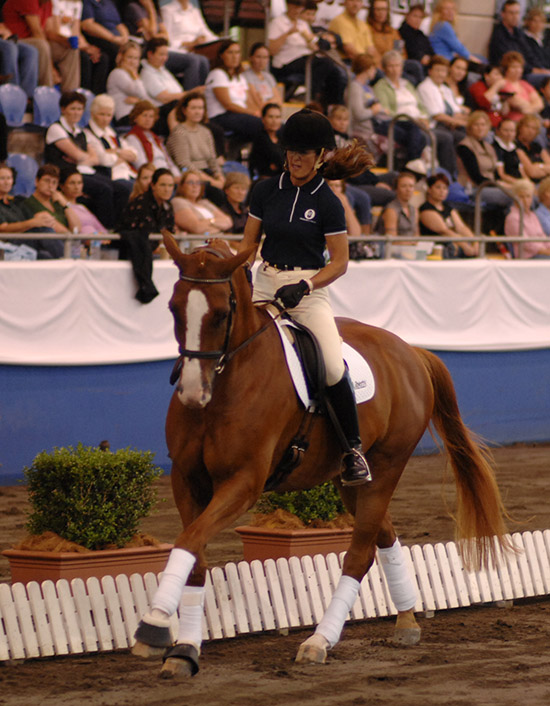
At every point, Steffen demonstrated what it is to be a thinking rider, examining each and every move…
“When I started with Jo Hinnemann, he asked, which part of your body do you use first? Legs? Seat?? No – the head. Making logical decisions is the most important point.”
What do you do about a horse that is tight in its back – a horse that holds his back?
“Floriano was a little inclined not to yield to the contact, so I rode walk / halt / walk, until he let go the neck and poll. When a horse is tight in the back then he is tight in the neck and poll. Simple, go to leg yielding, half passes in walk, get the horse yielding to the rein, address the back and address the hind legs.”
What do you do with horses that lose the four beat in the walk?
“My helpful hint is don’t buy any horse with a tricky walk. It’s very hard to fix horses that are very quick and horses with a huge extended walk – they tend to be lateral and rush. I’d do tons of transitions – halt / walk / halt, getting them a little more focussed on the rider and not speeding up. The tempo is related to the rhythm. If the tempo is too quick, then problems arrive, I would compromise, open the neck and slow the walk right down.”
You don’t seem to like horses stretching down?
“I never want to see a horse take advantage.”
“Putting a horse together is a bit more difficult than making a horse long.”
“If I get horses that brace up, then two or three times a week, they do nothing but stretching. But you do see a problem with lots of young horses that have been babied too long, and that makes it harder to put them together. It’s very individual, if a horse is too light in hand, and its tail is swishing, that’s the perfect horse to stretch very long.”
By this time, Nadia Coghlan had warmed up her gelding Carlyle, and she was explaining the issues with her horse: “He likes to take charge, he likes to rest on my hands.”
Steffen explained that with this horse, much of the work had concentrated on closing him up, getting his hindlegs under him, and for this he asks for some work in canter:
“See how much he can engage? And his back arches up now and he can’t be hollow. I love warmup in canter – lengthening and collecting. The first few days we were getting engagement, but not suppleness.”
And again, beware of getting deep: “He should go deep and round, but accept the contact respectfully.”
Time for Steffen to get on the horse, and again he was thinking about the contact: “As soon as he releases, I give, I love him to go forward but it must never be an evasion. I must be sure that when I ask for more expression, I still have the suppleness. Bring him back, increase the suppleness, he gives, go forward again. The corrections must be very quick, not strong, but quick.”
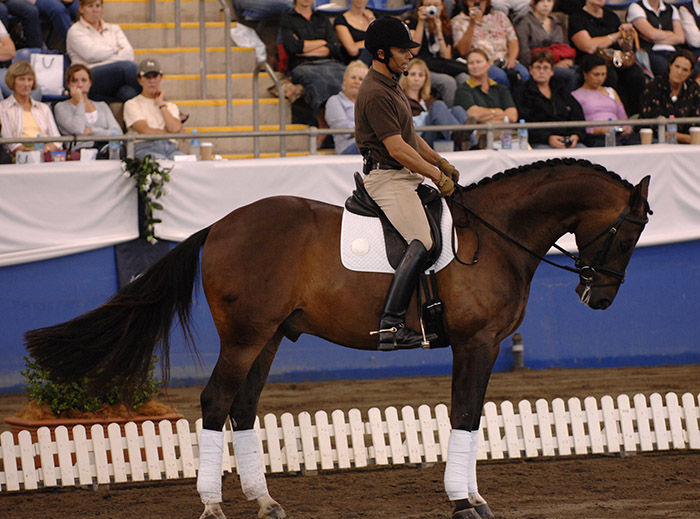
“Hot horses need a lot of work on walk, they relax better in walk than trot or canter. It is important not to get after the horse, repeat the movement.”
“When I ask for piaffe, he comes a little behind my hand – I don’t want that. There is no need to use the spur unless he sucks back. There should not be too much lower leg in collection, only upper leg and spur if you need it. Don’t crank your legs, tell him what you want and leave him alone… Ride him every step, the tension builds up with him, and you have to think outside the box. Soft contact and true carriage is always going to be your best friend with him.”
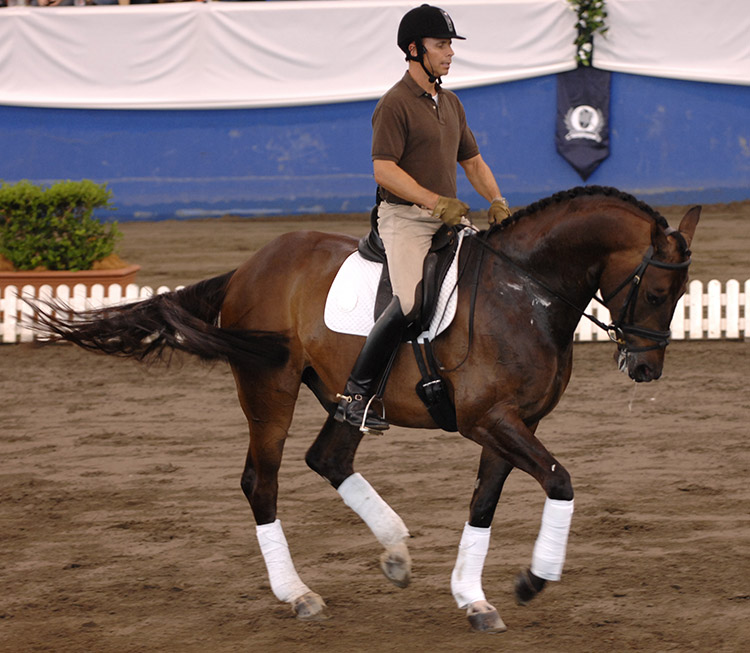
And talking of friends… Do your ever take your horses outside the arena?
“Horses should stay motivated. I like to go on a trail ride to cool them out. I usually work a horse for 30 minutes, but set aside an hour so I can walk outside. The grooms walk them around in the afternoon – just working in the arena is no good.”
more follows
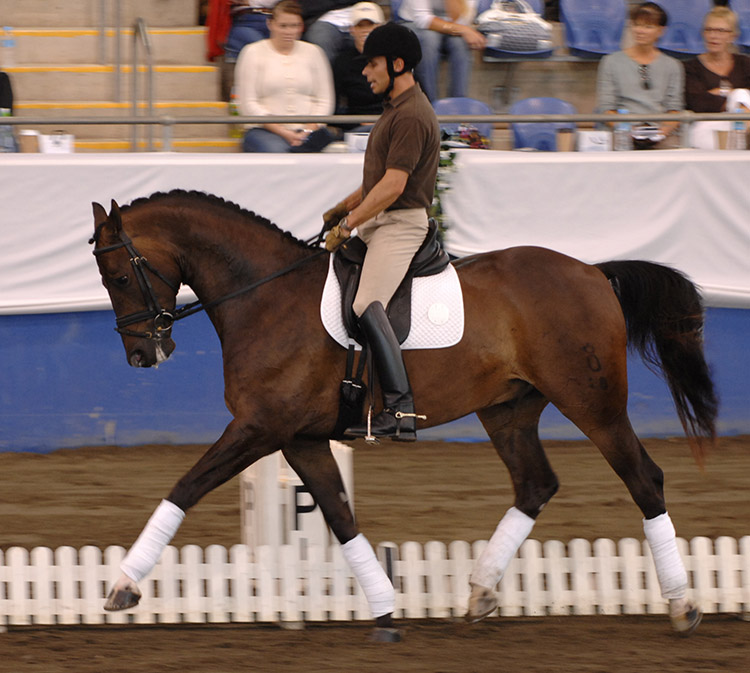
It had been a full session but there was more to come – Steffen was to ride Rozzie Ryan’s Grand Prix stallion, Jive Magic, and once again, the visitor impressed with his determination not to show off the tricks, but to honestly work with the horse:
“He is definitely a horse I would ride a little lower – even let him stretch. He wanted to get tight on my left rein, and instead of using my hand, I put my leg on and pushed him over and said ‘let go’. I want to get him over the back, move him a little sideways, then I’m happy to release him.”
It was interesting to watch Steffen ride, once the horses realised that the leg was not automatically accompanied by the spur, the dialogue between rider and horse through the leg was very subtle…
And Steffen soon had Rozzie back on her horse, reinforcing the points he had been making all the way through his clinic and the master class. Sure it’s nothing new, but it is sophisticated coaching at a level that we haven’t seen in this country before…
One last thought to ponder: “The horse may relax, the rider never.”



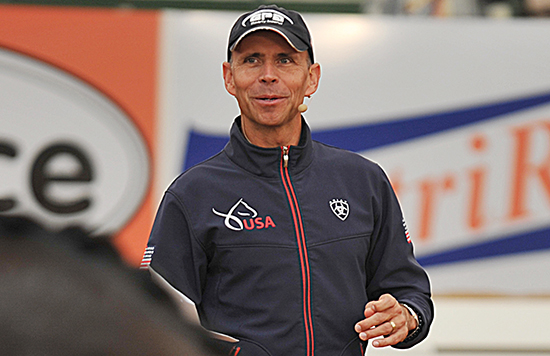
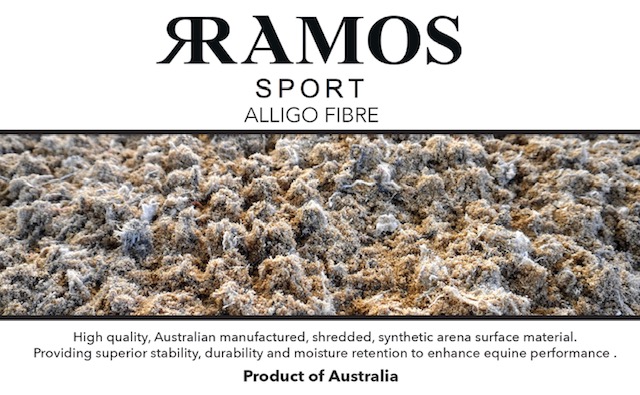
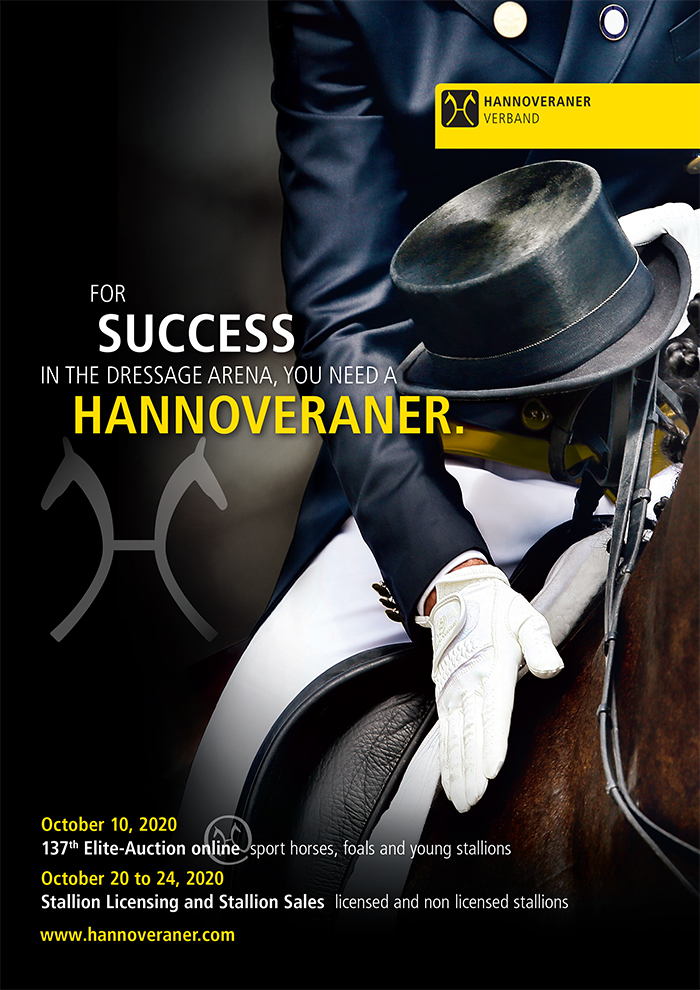
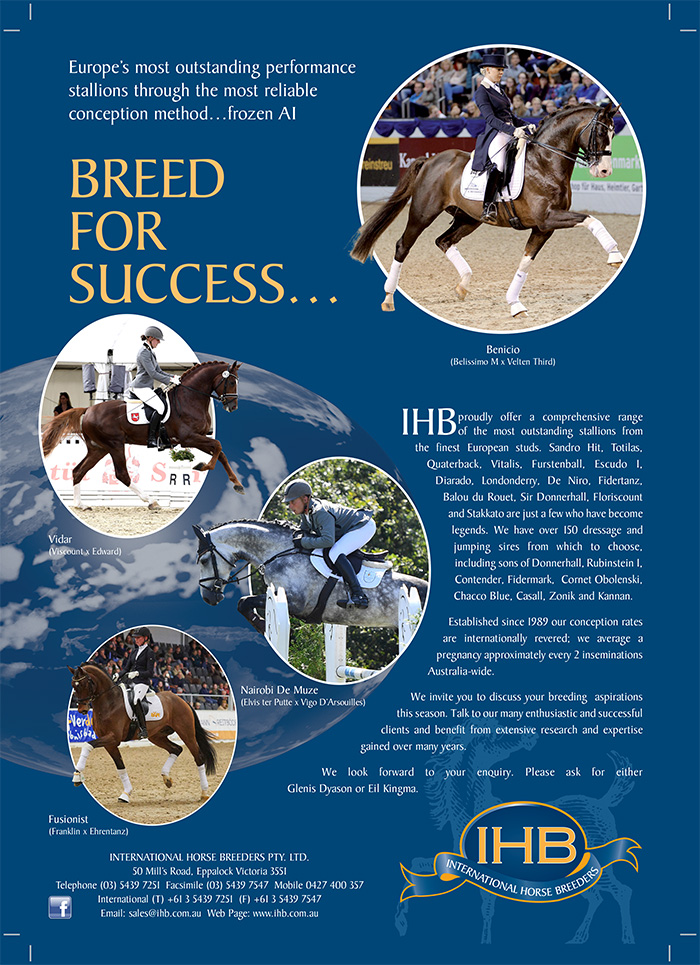
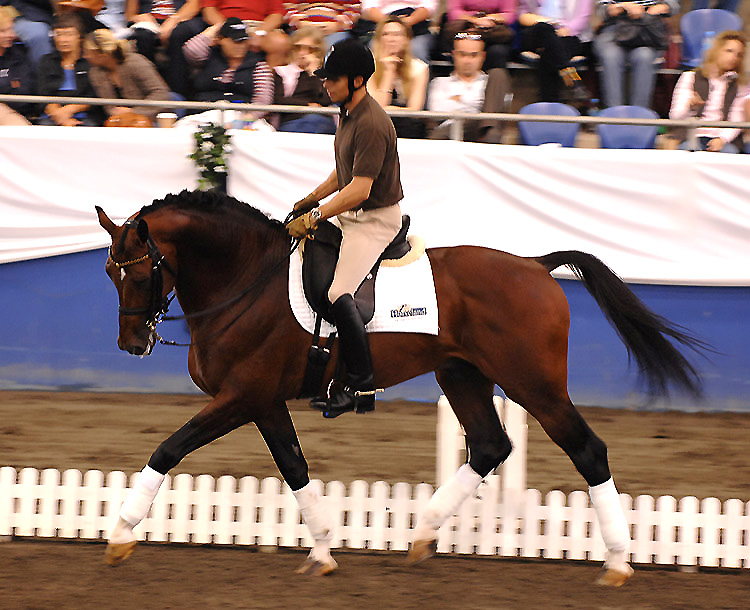
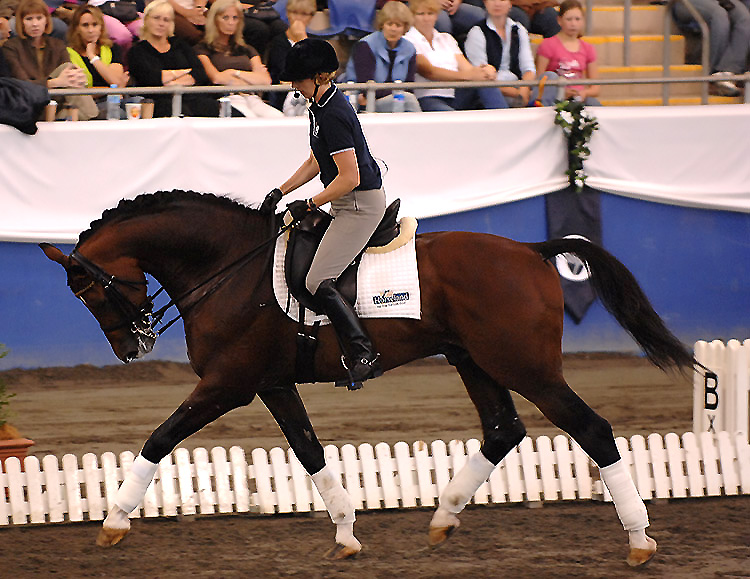
Fabulous read
Thanks so much for a clear and informative article! Steffen has no equal as an instructor in clinics – he neither showboats nor repeats truisms we’ve all heard. His specificity to each horse and rider is really instructive.